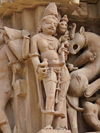|
Yama (यम)
Sanskrit-Pali. Vedic god of death. The judge of the dead and guardian of the
South. His name is related to the Sanskrit word yahma (याम),
which means ‘cessation’ or ‘end’. He is the
very powerful son of the sun god
Surya (fig.).
As the god of death, Yama executes the orders of
Kala, the god of time, as it is
time that eventually leads to death. His mount is a
buffalo
(fig.),
or sometimes a bull, and in India and Tibet, he is often depicted with a
bull's head,
in line with a popular myth about his origins. That particular myth relates that
a holy man was told that if he would spent 50 years living in deep
meditation in a cave, he would reach
Enlightenment. On the very last night before completing the 50 years, two robbers entered his
cave with a stolen bull. As they were in the process of beheading
the bull, they realized that the hermit had witnessed their act and
they decided to kill him. He begged them to spare his life,
explaining them that he would soon reach Enlightenment, and that all
his efforts would be lost if they would kill him before the 50 years
had expired. However, the thieves ignored his request and beheaded
him. Immediately, he assumed the ferocious form of Yama and put the
bull’s head on his own headless body. He then killed the thieves and
drank their blood from cups made from their skulls. However, in his
fury, he threatened to wipe out the entire population of Tibet,
causing the Tibetan people to appeal to
Manjushri for protection against Yama. In response, Manjushri assumed the form of
Yamantaka (fig.) and
defeated Yama, then turned him into a protector of Buddhism, and
thus
saved the people. To confront death, Yamantaka manifested the form
of death itself, but in a magnified appearance. Hence, in art, both
Yama and Yamantaka may be represented with bull’s heads, but Yama
can be distinguished by a
dhammachakka that he wears
as an ornament on his breast, a symbol of the Buddhist teaching and
his idiosyncratic mark. In
tantric
iconography, he may
appear standing on a bull, which is copulating with a woman lying on
the ground (fig.).
Another myth narrates that Yama was a king in Aryan times, who was
the first man to die, thereby venturing into the realm of the dead,
of which he eventually became the ruler (fig.).
In some instances, he is depicted with a large scale, used
to measure ones deeds and pass
down a
befitting judgment (fig.). In Thai,
called
Yom (fig.)
and
Phra Yom,
and in Chinese
Yan Wang
(fig.) and
Yan Mo
(fig.).
In the
Mahabharata
episode on the
Pandava
Tribe,
this deity
is associated with
(or known as)
Dharma, the god of virtue,
justice and morality, as well as of politics, and the
heavenly father of
Yudhishthira
with
Kunti, the first wife of King
Pandu.
Yama's
consort is known as
Yamuna. See also
Diyu
and
TRAVEL PICTURE,
and
WATCH VIDEO.
回






|

